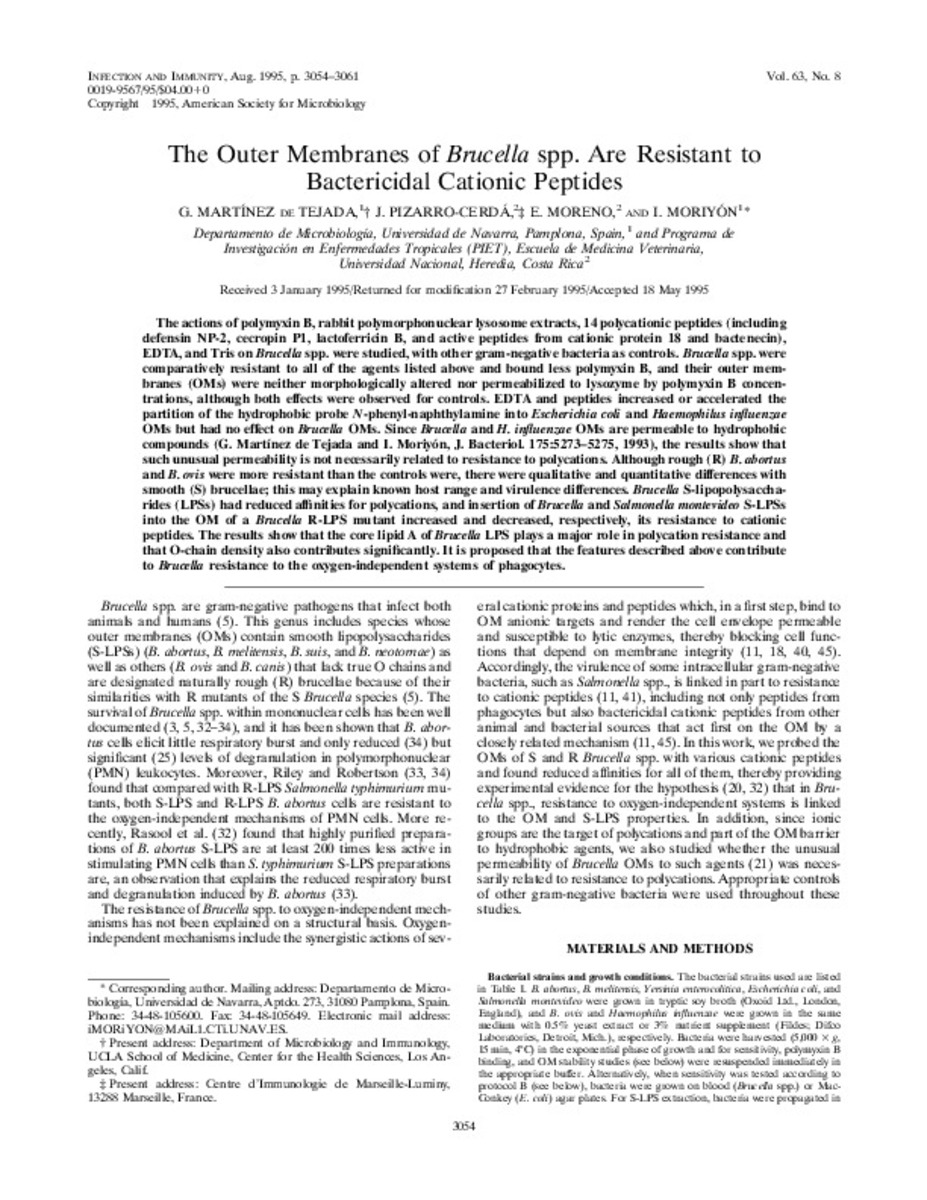Full metadata record
| DC Field | Value | Language |
|---|---|---|
| dc.creator | Martinez-de-Tejada, G. (Guillermo) | - |
| dc.creator | Pizarro-Cerda, J. (Javier) | - |
| dc.creator | Moreno, E. (Edgardo) | - |
| dc.creator | Moriyon, I. (Ignacio) | - |
| dc.date.accessioned | 2013-07-19T09:05:47Z | - |
| dc.date.available | 2013-07-19T09:05:47Z | - |
| dc.date.issued | 1995 | - |
| dc.identifier.citation | Martinez de Tejada G, Pizarro-Cerda J, Moreno E, Moriyon I. The outer membranes of Brucella spp. are resistant to bactericidal cationic peptides. Infect Immun 1995 Aug;63(8):3054-3061. | es_ES |
| dc.identifier.issn | 0019-9567 | - |
| dc.identifier.uri | https://hdl.handle.net/10171/29518 | - |
| dc.description.abstract | The actions of polymyxin B, rabbit polymorphonuclear lysosome extracts, 14 polycationic peptides (including defensin NP-2, cecropin P1, lactoferricin B, and active peptides from cationic protein 18 and bactenecin), EDTA, and Tris on Brucella spp. were studied, with other gram-negative bacteria as controls. Brucella spp. were comparatively resistant to all of the agents listed above and bound less polymyxin B, and their outer membranes (OMs) were neither morphologically altered nor permeabilized to lysozyme by polymyxin B concentrations, although both effects were observed for controls. EDTA and peptides increased or accelerated the partition of the hydrophobic probe N-phenyl-naphthylamine into Escherichia coli and Haemophilus influenzae OMs but had no effect on Brucella OMs. Since Brucella and H. influenzae OMs are permeable to hydrophobic compounds (G. Martínez de Tejada and I. Moriyón, J. Bacteriol. 175:5273-5275, 1993), the results show that such unusual permeability is not necessarily related to resistance to polycations. Although rough (R) B. abortus and B. ovis were more resistant than the controls were, there were qualitative and quantitative differences with smooth (S) brucellae; this may explain known host range and virulence differences. Brucella S-lipopolysaccharides (LPSs) had reduced affinities for polycations, and insertion of Brucella and Salmonella montevideo S-LPSs into the OM of a Brucella R-LPS mutant increased and decreased, respectively, its resistance to cationic peptides. The results show that the core lipid A of Brucella LPS plays a major role in polycation resistance and that O-chain density also contributes significantly. It is proposed that the features described above contribute to Brucella resistance to the oxygen-independent systems of phagocytes. | es_ES |
| dc.language.iso | eng | es_ES |
| dc.publisher | American Society for Microbiology | es_ES |
| dc.rights | info:eu-repo/semantics/openAccess | es_ES |
| dc.subject | Brucella drug effects | es_ES |
| dc.subject | Defensins | es_ES |
| dc.subject | Proteins phamarcology | es_ES |
| dc.subject | Xenopus proteins | es_ES |
| dc.title | The outer membranes of Brucella spp. are resistant to bactericidal cationic peptides | es_ES |
| dc.type | info:eu-repo/semantics/article | es_ES |
| dc.type.driver | info:eu-repo/semantics/article | es_ES |
Files in This Item:
Statistics and impact
Items in Dadun are protected by copyright, with all rights reserved, unless otherwise indicated.






